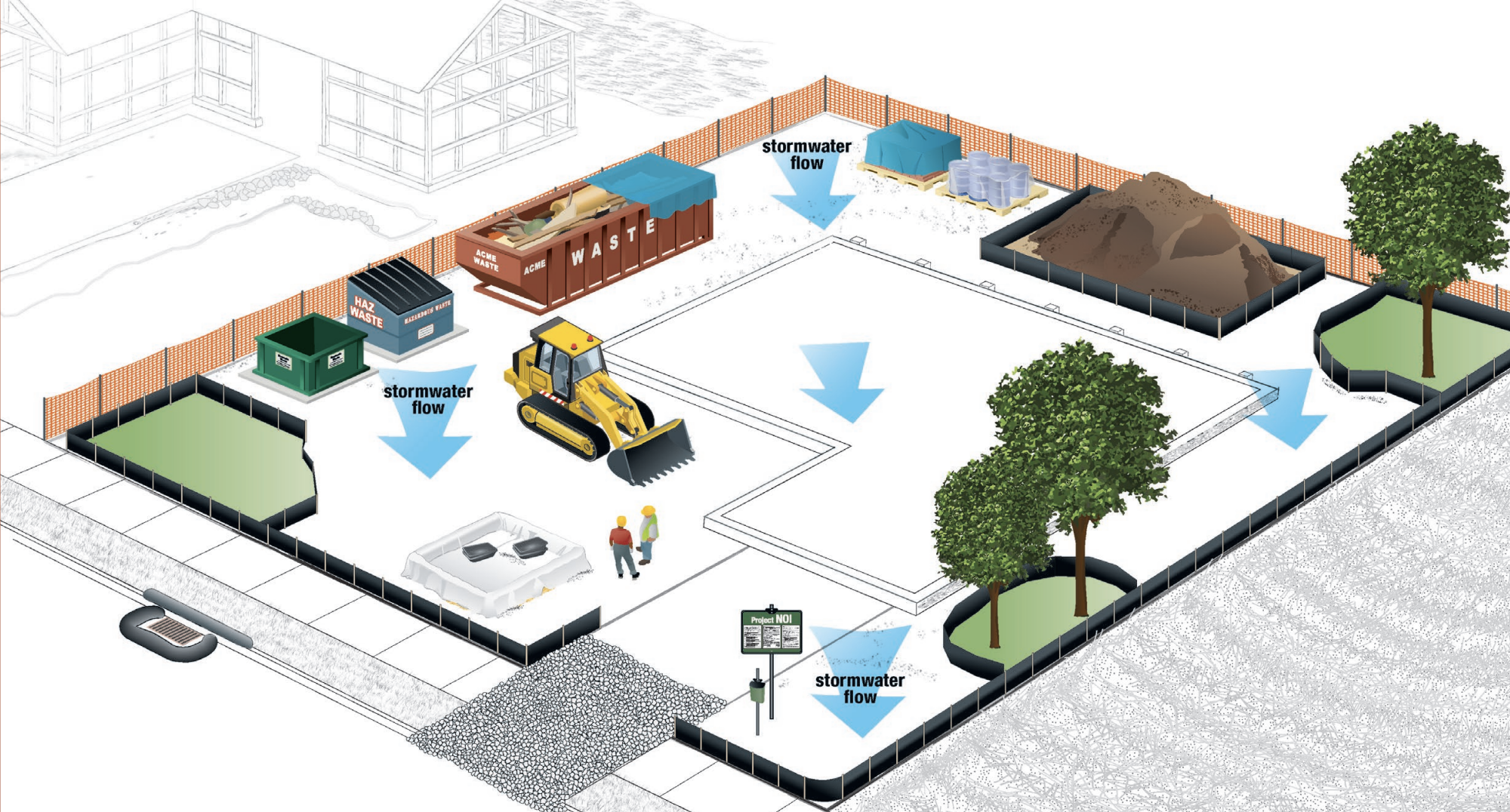Impacts from construction activity don’t just occur at the site but can travel well downstream into surrounding ecosystems.
From pollution to turbidity, water systems are vulnerable to the destructive impacts of soil erosion and worksite pollutants commonly found at construction sites.
The SWPPP, or stormwater management plan, is designed to eliminate these concerns by providing proactive steps for crews to follow to limit their impact.
This guide will detail the importance of the SWPPP in construction and everything construction managers need to know about developing an SWPPP
What Is a SWPPP?
Stormwater pollution prevention plans (SWPPP) are written documents designed to limit erosion and sedimentation that lead to stormwater pollution. An SWPPP is needed whenever a site plans to disturb one acre or more of land and discharge runoff into a public water system.
SWPPPs are living documents that require buy-in from all team members of your organization, including subcontractors and anyone who steps foot on your construction site.
Key Elements of the SWPPP
SWPPPs encompass virtually every element of your worksite and its activities to ensure that all possible variables are addressed. Some of the most important elements of the SWPPP in construction include:
- Site Description and Overview: SWPPPs begin with a detailed site description, including information on project size, location, and potential environmental impacts. The site description seeks to identify any areas of the site that are vulnerable to erosion so that subsequent steps may be taken to protect these areas.
- Erosion and Sediment Control: One of the primary focuses of SWPPPs is to control erosion and sedimentation. Plans outline specific measures, such as installing silt fences, erosion control blankets, and sediment basins, to prevent soil erosion and minimize the transport of sediment into stormwater runoff.
- Employee Training and Awareness Programs: Ensuring that construction site personnel are trained and aware of best practices is a crucial aspect of SWPPPs. These programs educate workers on pollution prevention measures, spill response procedures, and the importance of adhering to the SWPPP.
- Stabilization Techniques: SWPPPs detail stabilization techniques to establish vegetation and prevent soil erosion once construction activities are completed. This may involve seeding, mulching, and other measures to stabilize disturbed areas.
- Inspection and Continuous Documentation: Since SWPPPs are living documents that require continuous adjustment, all changes and related documents will be recorded in the SWPPP. All inspections and their results will also be recorded in the document.
When Is a SWPPP Required in Construction?
Anyone applying for an NPDES permit for general construction activity must submit a notice of intent (NOI) and a SWPPP to be considered. Phase II of the Clean Water Act also demands that sites that plan to discharge into municipal water systems (MS4s) develop a SWPPP.
The Importance of the SWPPP
Many construction managers may be reluctant to embrace greater regulation, but SWPPPs play a very important part in protecting ecosystems and ensuring worksite safety.
To start, SWPPPs protect local ecosystems from stormwater runoff that may carry pollutants or sediment. While sediment may not seem like a dangerous substance, increased turbidity (i.e., the dirtiness of the water) can actually have a catastrophic effect on aquatic life.
From a social perspective, preserving local ecosystems fosters better relations between local communities and construction crews. This sentiment applies to both urban and rural construction sites.
From a financial perspective, SWPPPs demand that construction managers practice more sustainable practices. In turn, this cuts down on the need to invest in stabilizing soil once construction activity has ceased so teams can simply move on.
Finally, SWPPPs help protect worker safety by mitigating the risk of flooding and also demanding better oversight over hazardous material handling.
Working with a Qualified SWPPP Consultant
Contact an environmental consultant if you’re interested in applying for a NPDES permit or need help developing a SWPPP. Path Light Pro specializes in SWPPP development, as well as quality assurance control for all construction projects. Path Light Pro can assist you in all your planning needs, from worker safety to energy efficiency.
FAQs: SWPPP in Construction
Who is responsible for developing the SWPPP for a construction project?
The responsibility for developing the SWPPP typically falls on the project owner or the party in charge of construction. This may involve collaboration with environmental consultants or professionals experienced in stormwater management.
When should the SWPPP be developed?
The SWPPP should be developed during the planning phase of a construction project, well before any ground-disturbing activities commence. It is a proactive document that guides the implementation of stormwater management measures throughout the construction process.
What happens if a construction site fails to implement a SWPPP?
Failure to implement a SWPPP can result in regulatory penalties and fines. The Environmental Protection Agency (EPA) and other relevant authorities may take enforcement actions against non-compliant construction sites, which can lead to legal consequences and additional costs.
How often should SWPPPs be updated?
SWPPPs should be regularly updated to reflect changes in project scope, conditions, or regulations. Regular site inspections may also identify the need for updates. Construction sites should maintain a dynamic SWPPP that adapts to evolving circumstances.
Are there specific requirements for SWPPPs based on the size of the construction project?
Yes, the requirements for SWPPPs may vary based on the size and nature of the construction project. Larger projects with higher potential for environmental impact may have more stringent requirements. It is essential to consult local regulations to determine specific criteria.


